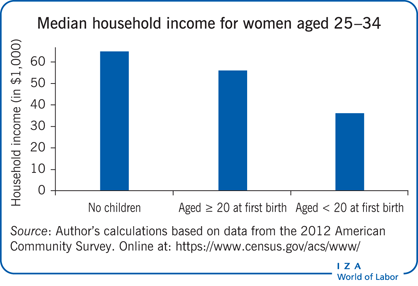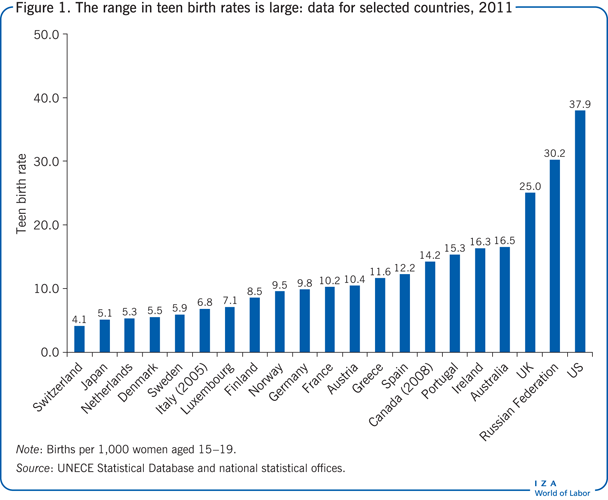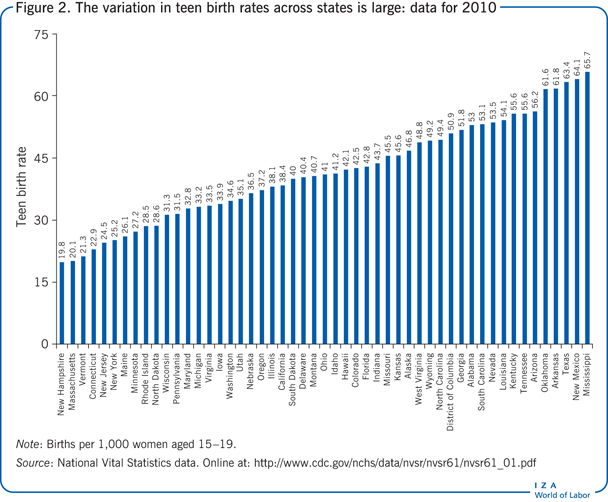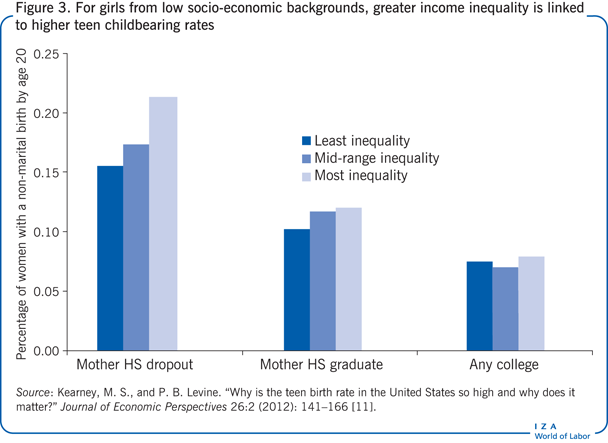Elevator pitch
It is not difficult to find statistics showing that teenage childbearing is associated with poor labor market outcomes, but why is this the case? Does having a child as a teenager genuinely affect a woman’s economic potential—or is it simply a marker of problems she might already be facing as a result of her social and family background? The answer to this question has important implications for policy measures that could be taken to improve women’s lives.

Key findings
Pros
Teens who give birth come from disadvantaged backgrounds and may have had inferior labor market outcomes anyway.
Traditional policies aimed at reducing teen pregnancy and childbearing have little, if any, impact.
Ethnographic studies find evidence of ambivalence toward pregnancy among disadvantaged teens.
Long-term factors, like greater income inequality (a potential marker for lack of opportunity/upward mobility), increase rates of teen childbearing.
Cons
Teens who become mothers have lower educational attainment and, subsequently, worse-paid jobs.
Better information and access to contraception appear to help reduce the likelihood of teen childbearing, if only to a limited extent.
Author's main message
Teen childbearing may be a contributory cause of inferior labor market outcomes for women, but its role is not substantial. To a great extent, teen childbearing is a marker of other, existing, social problems in a girl’s life. To improve employment and other economic outcomes for women, society must address the underlying social problems that lead women to become teen mothers in the first place, perhaps by concentrating on early childhood education and improving access to higher education.
Motivation
Women who give birth at a young age do less well later in life in many ways, including in the labor market. In the US only 51% of teen mothers graduate from high school by age 22, compared with 89% of women who do not become teen mothers. With high school dropouts earning around 75% of what high school graduates earn and 40% of what college graduates earn, dropping out of high school is plainly a clear path to economic disadvantage later in life. It is no surprise that half of teen mothers in the US live in poverty.
The difficulty in attributing causation to these stark statistics is that girls who become teen mothers are not a random draw of the population. According to one report, 36% of teen mothers grew up in two-parent households in the US, compared with 56% of other girls. Among teen parents, 28% grew up in poverty, compared with 16% of others. Another study reports that almost half of girls born to teen mothers go on to give birth as teens themselves [1]. These and other background differences are also correlated with subsequent economic disadvantage, which creates a problem in attributing causation. Is it the teen childbearing itself that leads to the inferior outcomes? Or were the girls who became teen mothers never on a path toward educational or economic achievement in the first place? Perhaps it was the realization that they had little to lose that led them to have children early.
Sorting this out is critical for policy. If teen childbearing itself is the problem, then the immediate behavior that leads to pregnancy should be targeted. But if the inferior outcomes are due to factors going back to early childhood, such interventions are likely to fail, as they will not address the source of the problem. The purpose of this paper is to help untangle this dilemma in the US.
Discussion of pros and cons
Approaches to identifying causation in teen childbearing
In theory, the best way to determine whether teen childbearing has a causal effect on subsequent outcomes is to use standard experimental methods, randomly assigning study participants into treatment and control groups. Random assignment means that statistically the two groups are as nearly identical as possible in all dimensions, including those that may not be observable to the researcher. A simple comparison of the difference in outcomes between the two groups, appropriately tested for statistical significance, provides a strong way to determine whether the treatment “worked.”
Clearly, this approach is not appropriate for analyzing the effects of teen childbearing. Girls cannot be randomly assigned to become teen mothers or not. Instead, researchers use statistical approaches that replicate the idea of a randomized experiment (quasi-experimental approaches). These methods can yield a stronger indication of causal effects than observational studies can. A body of evidence becomes particularly compelling when a number of alternative approaches yield similar results.
To date, three quasi-experimental approaches have been used to identify the causal effect of teen motherhood on subsequent outcomes. In one approach, the researchers compare outcomes across siblings who differ in their teen childbearing behavior [2]. Although siblings are not a perfect match for one another, sisters are likely to be more similar to each other than they would be to a randomly selected girl outside their family.
In a second approach, researchers use statistical matching methods that estimate the “propensity” that a girl will go on to give birth as a teen [3]. Girls who gave birth as teens are then statistically matched to other girls who did not, but who had similar underlying propensities to do so. It is beyond the scope of this paper to describe the details of this approach, but it is a standard empirical tool used by economists studying a wide range of topics.
A third method compares outcomes for teen mothers with outcomes for girls who became pregnant as teens but had a miscarriage (see, for instance, [4]). This approach treats a miscarriage as a random event, or at least one that is determined biologically rather than by a girl’s active decision-making. The premise is that pregnant teens who miscarry—and therefore avoid becoming teen mothers—provide a useful comparison group for girls who do become teen mothers. Both sets of girls become pregnant and are thus very similar in the most relevant respects. But, by chance, some of the girls go on to become teen mothers and some do not. Therefore, comparing their outcomes arguably reveals the causal effect of teen motherhood as distinct from the effect of the other background factors that led them to become pregnant in the first place. This approach is not perfect, in that miscarriage is not actually purely random—an issue that the authors of these studies address in detail—but these studies still provide a useful approach to address these issues.
These three approaches have produced reasonably consistent findings. Taken as a whole, the studies suggest that teen childbearing has only modest effects on subsequent outcomes. Rather, the evidence they present suggests that much of the observed correlation between teen childbearing and inferior outcomes is the result of underlying differences between those who give birth as a teen and those who do not. In other words, it is the set of factors that lead girls to become teen mothers that is responsible for teen mothers’ inferior outcomes later in life, not the fact of becoming a teen mother itself.
The effectiveness of traditional interventions
There are also important lessons from the accumulated evidence on the effectiveness of policies explicitly intended to reduce rates of teen childbearing. Conventional policies designed to target teen pregnancy focus on improving the information (like sex education) and resources (such as contraception) that are available to teens. Essentially, the effectiveness of these policies depends on how often teen pregnancies occur “by mistake.” If a teenage girl wants to avoid an accidental pregnancy so as not to fall “off track” but is not altogether sure how to do this, then providing her with additional information on how to protect herself and making it easier for her to come by the means to do so would have a major effect.
For some girls, however, becoming a teen mother might not represent a deviation from the way they see their life course. This is not to say that such girls “try” to get pregnant (although that may be true in some cases), but rather that they might not care whether they do. This view would be consistent with a world in which inferior economic outcomes are not causally related to becoming a mother during the teen years but are a consequence of other, underlying problems. If so, then conventional policies are unlikely to be successful because they do not address the true problems these girls face—the problems that led them to become teen mothers in the first place.
In fact, the evidence suggests that these traditional interventions do not have much of an effect on the likelihood of teen pregnancy and motherhood [5]. Sex education programs have been extensively evaluated using both experimental and quasi-experimental methods. A careful summary of the findings indicates that some of the best sex education programs have some effect, such as improved contraception knowledge or delayed initiation of sexual activity, but that the effect is not large [6]. No evidence has yet linked those changes to lower rates of teen childbearing. Abstinence-only programs have been evaluated with a large-scale, experimental study with randomly assigned treatment and control groups [7]. The results provide no indication that abstinence-only programs have much of an effect on any teen behavior, including childbearing. The effect of providing free family-planning services, including contraception, within the context of expansions to the Medicaid program, has also been evaluated [8]. Although this study detected a cost-effective reduction in teen childbearing in response to the free provision of these services, the magnitude of the effect is modest.
Taken as a whole, this body of evidence suggests that policies targeted directly at the mechanistic drivers of pregnancy (sexual activity and contraception) are unlikely to have a substantial effect on teen childbearing. If they are cost-effective and have at least some effect, as in the case of the public provision of family-planning services, they certainly should be supported. It is important, though, to recognize the limits of their effectiveness in bringing down rates of teen childbearing. Modifications that may make these policies more effective should continue to be explored but, based on existing knowledge, it seems likely that they are, to a large degree, attacking a symptom and not the underlying cause of the problem.
So what does cause teen childbearing?
If teen childbearing is best considered a symptom rather than a cause of inferior economic conditions, it is a marker of a social problem. From a policy perspective, therefore, this marker might be used as a way to learn how to improve outcomes for these women. A better understanding of what leads some girls to become pregnant as a teen can lead to a better understanding of what issues policies should target in order to improve how these teens fare later in life.
Insights from an ethnographic study
Ethnography, the study of cultural phenomena and of people in the context of their culture, falls outside the scope of economics but yields important insights that can be incorporated into more formal economic and econometric analyses. Ethnographic evidence is strongly complementary to economic evidence because it provides a rich, nuanced perspective of actual individuals. This type of evidence can provide insights into individual motivation and behaviors that are difficult, if not impossible, to gain from the perspective of an economist who, as it were, peers down from above on large-scale, quantitative data. On the other hand, from that height, economists are able to make claims about broader societal patterns that can only be detected with their wide lens.
Although ethnographic contributions on this topic began at least 50 years ago, some particularly important work has appeared within the last ten years [9]. Two researchers, both women, spent several years living in inner-city Philadelphia, Pennsylvania, and Camden, New Jersey, getting to know the residents and conducting in-depth interviews with dozens of young, single mothers. An important lesson from their work is that growing up in an environment where there is little chance of social and economic advancement leads women to bear children at a young age. These women perceive that they have so little chance of success in life that they see no reason to postpone having a child and may even benefit from having one, regardless of marital status. If their perspective is correct, it would naturally follow that these women will experience poor social and employment outcomes. It is their expectation of precisely such outcomes that leads them to have a child in the first place.
A causal link between lack of economic opportunity and teen childbearing
The challenge that economists face is whether these decisions about teen pregnancy can be placed in the context of an economic model and whether broader evidence can be found in society more generally that supports these insights. A 2012 study accepts this challenge [10]. The study’s empirical work takes advantage of the extensive geographic variability observed in teen childbearing. This variation is considered both a challenge and a potential clue to identifying factors that might be important for understanding rates of teen childbearing.
Before describing how this variability is used, its existence must be verified. The range in teen birth rates across high-income countries in 2011 was large, on the order of almost ten to one between the highest teen birth rate country, the US (37.9), and the lowest, Switzerland (4.1; see Figure 1). Variation across states in the US is also large (see Figure 2). Teens in the highest teen birth rate states (Mississippi, New Mexico, and Texas) are more than three times more likely to bear children than teens in the lowest teen birth rate states (New Hampshire, Massachusetts, and Vermont). More than 6% of teens in high teen birth rate states give birth in a single year. That is around 15 times the rate in Switzerland. It also means that if it is assumed that each childbearing teen has just one pregnancy over the five-year period in which teens fall into the 15–19 age bracket, then more than 30% of teens in that age bracket will have had a child by age 20.


Why do some of these locations generate levels of teen childbirth that are so much higher than others? Previous work and the study described here [10] argue that a critical factor in teen childbearing is lack of economic opportunity. Obviously, this hypothesis is prompted by the ethnographic evidence summarized earlier. But what needs to be established is that the lack of economic opportunity is somehow causally related to the geographic variability in teen childbearing observed in the data.
Although economic opportunity is difficult to measure, the study attempts to capture it empirically using the level of income inequality in a particular location [10]. It finds that income inequality and mobility are very highly negatively correlated, such that individuals at the bottom of a very disperse income distribution are more likely to remain where they are than others further up. This is where a connection is drawn to teen childbearing. If you are at the bottom of a tall income ladder without much chance of moving up, then there is little cost to having a baby at a young age. This can be described as an economic model of “despair”: since there is little or no cost (and there may even be a benefit) to having a child as a teen, girls respond accordingly. Again, although economic analysis is used in this work, these ideas are strongly linked to the ethnographic research undertaken in Philadelphia, Pennsylvania, and Camden, New Jersey [9].
Thus far, measures of aggregate income inequality have been correlated to levels of aggregate teen childbearing, and a strong positive relationship between the two has been found: locations with greater inequality have higher teen birth rates. This is not good enough, however, to establish a causal relationship, since high-inequality locations are different from low-inequality locations in a large number of ways beyond their greater inequality. In essence, what is needed is something resembling a control group within each of those locations to help determine whether a causal effect has been identified.
To that end, micro-data for the US are used on differences in the long-term level of income inequality across states. Women are distinguished by their position in the income distribution and the level of inequality in their state. It is known that girls from lower-income families have higher rates of teen childbearing than girls from higher-income families. The research asks further whether the rates vary according to the level of income inequality where they live [10]. Position in the income distribution is proxied by maternal education, since the data do not record the income of a person’s family when that person was a child. Children of mothers who are high school dropouts are classified as being at the bottom of the income distribution, children of mothers who are high school graduates are in the middle, and children of mothers who have some college education are at the top.
If the rate of teen childbearing among girls at the bottom of the distribution increases as the gap between the bottom and the middle of the distribution grows, then that would be consistent with the “despair” hypothesis. The hypothesis does not apply to girls in the top part of the income distribution—a larger gap between the bottom and the middle does not make it harder for them to move up—so there should be no corresponding increase in the rate of teen childbearing among girls from more educated families based on the level of income inequality where they live.
That is just what analysis of the micro-data shows (see Figure 3). Among girls from low socio-economic status backgrounds, greater income inequality (as measured by the gap between the middle and bottom of the income distribution) is linked to higher teen childbearing rates. The magnitude of this effect is substantial. Moving from a low-inequality state to a high-inequality state increases the likelihood of giving birth by age 20 by 5 percentage points. Relative to the base rate of childbearing by age 20 in low-inequality states, this represents an increase of about one-third.

It is possible to conclude from this finding that lack of economic opportunity is an important contributor to teen childbearing. This suggests that the way to improve girls’ subsequent employment outcomes is to improve their economic opportunities, which can be done through policies supporting early childhood education and greater access to higher education, which have proven successful in upgrading economic (and other) outcomes. A side benefit of these policies, according to this view, would be a reduction in rates of teen childbearing. In fact, some studies of the effectiveness of education interventions have found reductions in teen childbearing, although that was not an explicit goal of the intervention.
Limitations and gaps
Overall, in interpreting the evidence on the cost of teen childbearing, it is important to keep in mind the nature of the experiment being conducted. Broadly speaking, the “treatment” group comprises women who gave birth in their teens, and the “control” group women who likely gave birth shortly thereafter. If teens who give birth could instead delay their childbearing further and along the way invest in more education, establish stable relationships, and engage in other activities that lead to better economic and other outcomes, the improvement associated with delay might be even greater.
The research findings should not be interpreted too literally in moving from the research to specific policy interventions. One should not conclude from this discussion that policies promoting sex education and providing greater access to contraception to teens are not useful. They may satisfy other goals, such as making it easier for teens to avoid a pregnancy even if they would have done so anyway. What the research shows is that such policies do not have a large effect on teen childbearing—not that they have no value in a broader sense.
Summary and policy advice
The high rate of teen childbearing in the US is typically considered a societal problem because of the costs it imposes on young mothers. However, teen childbearing is more appropriately viewed as a societal problem because it indicates other underlying difficulties facing some young women that lead to inferior subsequent outcomes, of which teenage pregnancy is just one. Research provides valuable insight into the importance of both interpretations. Although teen childbearing may well contribute to poor outcomes, its causal influence is vastly overstated in comparing outcomes between girls who do and girls who do not have children in their teens. Evidence also indicates that a lack of economic opportunity is important in generating teen births and poor subsequent outcomes.
These findings ought to inform discussions on how best to intervene to improve outcomes for women. Traditional policy interventions focusing on better information about contraception and on easier access to birth control for teens may not be the best way to intervene, although improving access to contraceptives, in particular, has been shown to provide some benefits and should be supported. Beyond that, the results presented here suggest that improving girls’ economic opportunities, by implementing programs known to be successful, like expanded early childhood education and improved access to college, could be effective additions to the policy menu.
Acknowledgments
The author thanks an anonymous referee and the IZA World of Labor editors for many helpful suggestions on earlier drafts.
Competing interests
The IZA World of Labor project is committed to the IZA Guiding Principles of Research Integrity. The author declares to have observed these principles.
© Phillip B. Levine